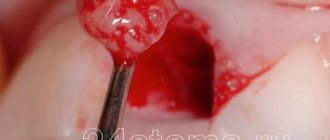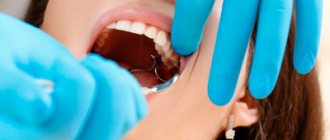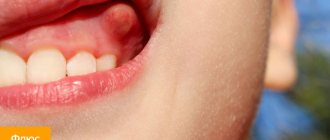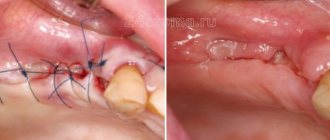.
The tongue is an important organ in the human body, but it is remembered only when it begins to hurt. The tongue can get sick not only from infection, but also from mechanical stress. What does it mean? The tongue rubs against the uneven edges of the teeth.
The most common situation is the chipping of a small section of a tooth. Such a nuisance can happen to anyone. As a result, the uneven edges of the tooth begin to cause discomfort, interfere with normal eating and cause pain during conversation.
Wounds on the sides of the tongue - marks from teeth
If you delay treatment of an injured tongue for a long time, you can get serious inflammation, which can lead to infection of the entire oral cavity.
Treatment
The dentist selects the correct treatment method depending on the nature and extent of the damage.
If a piece of a tooth breaks off, but the root and most of the crown survive, it can be restored in the following ways:
- Filling. It is used when, after a chip, a cavity with intact walls has formed.
Pros: - low cost; — speed of the filling procedure.Cons: — decreases in volume over time; — does not seal the defect hermetically; - not suitable if the front tooth or canine is broken.
- Tab. A more durable analogue of a filling can be used even when half of a tooth is broken. Most often used to restore molars.
Pros: - strength; — no shrinkage; — speed of the procedure; - service life is longer than that of a filling.Cons: - relatively high cost; - not universal.
- Ceramic veneers. Thin plates that are placed on the front surface of a crown to build up a chipped tooth.
Pros: - good cosmetic effect; - can be used for chipped incisors.Cons: - used only for minor damage; - several visits to the dentist will be required; - high price
If a significant part of the crown has broken off or the tooth has broken at the root, the doctor will suggest installing a denture. Before this, preparation is carried out - grinding the surface, if necessary, removing the nerve and filling the root canal.
If the root is damaged during a fracture, its remains are removed, a pin is installed and a prosthesis (crown) is fixed onto it.
What to do
If the tongue is rubbed by a tooth, then it is necessary to assess the degree of chipping. Small chips smooth out quite quickly on their own and no longer cause discomfort. There is no need to treat this tooth, because it does not pose any danger.
All small wounds and abrasions on the tongue will heal very quickly.
To speed up the tongue recovery process, you should refrain from hot, salty and spicy foods. The pharmacy sells special creams and gels that can be used to lubricate damaged areas on the tongue.
Broken tooth requires treatment
Well relieves inflammation using lotions using sea buckthorn or rosehip oil. Apply a moistened cloth to the damaged area for 10–15 minutes. The procedure must be carried out three times a day.
Before going to bed, you can rinse your mouth with propolis tincture. It needs to be diluted more with water. You can simply anoint the rubbed areas with honey.
If a large section of a tooth has chipped, then you cannot do without a dentist. The dentist will sand down all sharp edges and treat them with a special product. It may be necessary to restore the tooth or even resort to prosthetics.
Contacting your dentist will help eliminate the cause of the rubbing.
What to do if it is not possible to go to the dentist in a timely manner, and your tongue begins to rub on your teeth. This situation can happen during a vacation outside the city.
In this case, you can use improvised means. To help smooth out sharp edges:
- file with fine abrasive;
- glass nail file;
- sandpaper with the finest grit.
Clear teeth marks on the tongue
The selected item is first soaked in alcohol or any disinfectant. Light stroking movements smooth out the damaged area. Do not press too hard, otherwise the enamel and gums will be damaged. It is recommended to use this method only in extreme cases.
If a broken tooth has caries and a dark spot appears after a chip, then you should not put off visiting the dentist for too long. Dark staining of the enamel indicates that a destructive process has been activated in the tooth tissues. If the tooth is not treated in time and a filling is not placed, it will have to be removed in the near future.
Injury from sharp edges of fillings
Sometimes, due to serious facial injuries, it happens that a piece of the tooth breaks off below the gum level. In this case, the pain will be very intense. With a deep chip, the gums can be injured. Sometimes a nerve is even exposed. In such a situation, you should immediately consult a doctor. The specialist will take a photo and decide whether the tooth can be healed or whether it will have to be removed. If immediate contact with a doctor is unrealistic, then it is recommended to rinse your mouth as often as possible. For rinsing, it is better to use a decoction of chamomile or sage. If you experience severe pain, you need to take a painkiller.
With such large chips, the gums are usually cauterized or practice is performed. After this, a filling or crown is installed using standard technology.
Consequences
The consequences of a broken tooth are not only unpleasant, but also dangerous to health:
- if an incisor breaks, this affects the appearance and clarity of speech;
- a decrease in the chewing surface can cause insufficient grinding of food and, as a result, digestive problems;
- the defect becomes a favorable place for the growth of bacteria, which leads to caries, inflammation and suppuration of the gums;
- if a tooth breaks off and scratches the mucous membrane or tongue, this also provokes the development of infection.
Causes of chafing
The cause of tongue rubbing can be not only a broken tooth, but also other factors:
Poorly placed filling. Low-qualified specialists in inexpensive clinics sometimes treat their work with negligence. As a result, the placed filling has uneven edges. All excess material slowly begins to cause discomfort in the mucous membrane of the tongue. Sometimes this rubbing reaches the muscle organs.
Uncomfortable dentures. Some people wear dentures, but they can sometimes be uncomfortable. At the initial stage of wearing, a complex orthopedic design can injure the entire oral area. Inconvenience is caused by a poorly polished surface, large prosthetic elements and locking joints.
An uncomfortable denture can hurt your gums and tongue.
Prevention
Taking care of your oral health in a timely manner is much easier, cheaper and painless than treating a chipped tooth. A few simple tips will help make your teeth strong and prevent chips and fractures:
- Care for your mouth regularly, use rinses and dental floss after meals. It wouldn't hurt to have your teeth professionally cleaned.
- Do not overeat too hot or cold food and, especially, do not mix them.
- Get rid of bad habits - biting nails, pencils, biting threads.
- Eat well, include calcium, magnesium and vitamins in your diet.
- Limit your intake of sweet and sour foods.
- Visit your dentist 1-2 times a year to replace old fillings, put in new ones, get rid of tartar and get advice.
If a tooth breaks or chips, do not put off going to the dentist. The defect may be more serious than it seems at first glance. Some fractures, for example those with a crack at the root, should never be ignored. Only a specialist can assess the real extent of the damage.
Don't forget that disease is easier to prevent than to cure. Take care and strengthen your teeth - the stronger they are, the less susceptible they are to chips and fractures.
Broken wisdom tooth
Dentists almost always recommend getting rid of wisdom teeth right away. After all, they can cause a lot of trouble. Due to their atypical location, significant discomfort occurs in the oral cavity. In addition, they may erupt with pain.
Let's try to figure out whether it is worth removing a wisdom tooth if it is cracked. Removal should only be considered if the tooth in question is causing a lot of trouble. If it has a normal shape, does not hurt and has grown correctly, then it is better to treat it. A wisdom tooth is a regular tooth and is treated in the same way. In any situation, you should not rush to remove it, because no tooth is superfluous.
Reasons why a tooth may chip
- When teeth are injured, they often chip.
- The immune system affects the strength of tooth enamel.
- There is an imbalance in the hormonal system in the body.
- Eating hard and unhealthy foods can lead to chipped teeth.
- An incorrect bite can cause damage to the integrity of the teeth.
- Tooth enamel is in the stage of demineralization.
- Presence of a crack in the tooth.
Poor bite is one of the most common causes of chipped teeth. When chewing food, the teeth of the lower and upper jaw injure each other and cause chipping. Nighttime teeth grinding can also cause chipped teeth.
Bad habits (smoking, alcohol) thin the enamel of teeth, on which cracks may appear that turn into chips. An imbalance in the acid-base balance in the mouth also thins the enamel, which becomes fragile and breaks easily.
Chronic diabetes mellitus causes hormonal imbalance, which affects dental health.
How to restore a tooth?
Modern aesthetic dentistry has several techniques for restoration after damage:
- aesthetic restoration using composite materials;
- microprosthetics: using inlays, lumineers, onlays, veneers;
- root canal treatment, placement of a pin and orthopedic crown;
The doctor determines which type of restoration to use after examination and after diagnostics. The price of dental diagnostics can be found on the website or by calling the clinic’s phone number. If the tooth cannot be saved, it is removed and implantation is planned.
Problems and inconveniences during dental treatment
After installing the braces system and starting treatment, the patient may experience various inconveniences. We have prepared special material on the most common problems and ways to solve them.
Content:
- 1. Cheek scratching
- 2. Arc problems
- 3. If your teeth hurt
- 4. Food restrictions
- 5. If the bracket falls off
- 6. If the diction has changed
- 7. Problems with intermaxillary elastics
If something rubs or scratches your cheek
Take a mirror and look at your teeth in bright light. Try to find out which part of the system scratches the mucous membrane of the tongue or cheek. During the first 2-3 weeks, the uneven edges of the braces may scratch or rub the mucous membranes of the cheek, lips or tongue. If this causes serious inconvenience to you, take the protective wax that we gave you on the day your braces were installed. But remember that without wax you will quickly get used to orthodontic equipment.
Take a small piece out of the wax box, roll a small ball in your hands and knead it on the protruding hook of the bracket. The bracket itself or the tip of the arch, first blot saliva with a paper napkin. After some time, the wax may fall off, then repeat this procedure again.
Metal ligatures (white metal ligatures). The tails remaining from metal ligatures are bent towards the tooth and usually do not interfere at all. If, within a month of actively brushing your teeth with a brush, the tail of the ligature becomes bent and scratches the oral mucosa, then the patient, independently, but very carefully, can bend the tail of the ligature under the arch with half a wooden toothpick.
Arc problems
The arch is not fixed rigidly in the locks on the last teeth. It fits freely into the locks and can move back and forth without restrictions.
1. If, while eating, the initial super-elastic arch has popped out of the last lock and is in the way, you can insert it back yourself. To do this you need a mirror, good lighting and tweezers (nail clippers). With one hand, pull back the cheek, and with the other, take the tip of the arch with tweezers, very carefully, without bending the arch 90 degrees, insert it into the lock (the lock is a tube into which the arch is inserted).
2. The tip of the arc digs into the gum or cheek. As the teeth are aligned, the arch takes on a more even shape, and the end of the arch may come out of the last locks, injuring the mucous membrane of the cheeks or gums. In this case, if this causes serious discomfort (“I can neither eat nor speak”), you can come up without an appointment and the doctor or his assistants will cut off the problematic tip of the arch (if the tip has protruded by more than 3 mm).
If your teeth hurt
a) After installing braces, in the first 3-4 days you will experience pain only when biting or chewing food. It happens that teeth hurt for up to 10 days (very rarely). Sometimes there may be no pain at all, this is also normal.
b) After activation (control visit), during which the arch was replaced, the tooth/teeth may ache for 1-2 days, but also only while eating. Rarely do any patients resort to using painkillers these days, but if you feel the need for this, take those painkillers (ketanov, Nurofen, Nise, etc.) that you have on hand.
c) During the procedure for removing braces, the patient experiences slight discomfort (but it lasts 1-2 minutes) AND THAT'S ALL!!! THERE WILL BE NO OTHER PAIN SENSATIONS!!!
Food restrictions
To avoid damage to the equipment, you may need to avoid certain products. It is impossible to list all the foods that cannot be eaten, but each patient must determine for himself the force with which he can bite into his favorite food without damaging the braces.
We recommend not to eat: nuts (in any form), crackers, dried fruits, hard confectionery, caramel, toffees, sweets (especially grilled), hard toast, unhulled seeds, popcorn, chips. Raw carrots, radishes, turnips, hard fruits (apples, pears can be cut into slices), fruits containing seeds (peaches, plums, apricots, cherries, it is better to break them, cut them or separate the stone).
In the first months of treatment (in the initial arcs), you should not combine cold and hot foods together (ice cream and coffee, cold yogurt and a hot drink, etc.). Sudden temperature changes can disrupt the properties of the arc (the most important element in the bracket system).
If a brace falls off
Why do braces fall off, reasons?
- 1. When chewing or biting off hard food.
- 2. If you try to pick out something stuck under the archwire or between the braces on your own.
- 3. If the teeth have changed their position and there is contact of any tooth with the brace of the opposite jaw. If you do not notice this and do not tell the doctor about it, then, most likely, the braces will fall off as soon as you eat or when you force your teeth together.
Often in such cases, the patient does not immediately detect this problem. And to his surprise, while brushing his teeth or the next day, he identifies a lock that has fallen off, for a reason unknown to him.
What to do?
If you have external braces:
- — try to quickly make an appointment for an unscheduled appointment;
- - if you wear intermaxillary elastics, then stop wearing the elastics until the bracket is glued.
If you have internal braces:
- — try to quickly make an appointment for an unscheduled appointment;
- - if you wear intermaxillary elastics, then stop wearing the elastics until the bracket is glued;
- - do everything so that the bracket does not get lost;
- - if this is a bracket on the last tooth, and the arch is not bent behind the bracket, then try to very carefully remove it from the arch and save it. If the bracket does not come off, do not apply any force; you may damage the adjacent bracket. Leave it in place, it won't get lost.
If the diction has changed
Diction may change slightly only with lingual (internal) braces. With the new miniature lingual braces INCOGNITO, there is virtually no impairment of diction. But if you still encounter a similar problem, short-term exercises with ditties and tongue twisters will help restore your eloquence:
There is firewood in the yard, the gang is on the firewood, the gang has grass, all the gang are used for firewood. Karl stole dollars from Clara, and Clara stole the quarterly report from Karl. The workers privatized the enterprise, privatized it, but did not privatize it. The beggar rustles in thousands and fifty thousandths. The highest echelons marched towards their sponsored people along the highway, drunk. Regulators regularly adjusted the regulators. It is not clear whether the shares are liquid or not. Taxable grace. The guru's inauguration went off with a bang. The exhibitionist has small biceps. The moron got into the habit of doing bodybuilding. Sasha herself is perfection, and she’s also improving herself! Unpromising. In Kabardino-Balkaria, valocardine is from Bulgaria. De-ideologized, de-ideologized, and pre-ideologized. He who does not work does not eat what he who works eats. Turner Rappoport sawed through the pass, rasp and support. Coconut cookers boil coconut juice in coconut cookers. The eyes of a gazelle were staring at her from behind the spruce tree. Underqualified. Sasha walked along the highway and sucked on a dryer. Senya is carrying hay in the canopy, Senya will sleep in the hay. The cap is not sewn in the Kolpakov style, the bell is not poured in the Kolokolov style, the cap needs to be re-packed, re-capped, re-forged, re-capped. The heron wasted away, the heron was withered, the heron was dead. From under Podvypodvert.
After 3-4 days of training, your diction will become even better than before installing braces.
Problems with intermaxillary elastics
1. Take your time to remove the elastic on the first day of your appointment. Before removing the rubber bands the doctor put on, study which tooth they were put on, so as not to confuse them in the future, because... it makes a big difference. And neither the administrator nor the doctor will help you over the phone.
2. Sometimes elastics break within 24 hours. Because one elastic should be changed 1 or 2 times a day (as prescribed by the doctor), we recommend carrying a bag or small box with a small number of replacement elastic bands.
3. You need to remember and know what animal is drawn on your bag, because... Sometimes the rubber bands in the bags run out, and the patient or his parents can drive up to the clinic, name the animal on their bag to the administrator and receive a new bag of rubber bands. Or tell your doctor about it at your scheduled visit.
It is important not to take breaks in wearing, because... The result achieved in months, you can lose in a week of not wearing elastics. Only a doctor can cancel elastics. Just because your bag is out of rubber bands doesn't mean you don't need to wear them anymore.
4. If the hook falls off, the arc jumps out of the lock, the lock on which the elastic was put on, or any other lock breaks while wearing elastics, then in this case you need to stop wearing elastics and report the problem to the clinic.
During treatment there will be some tooth mobility, this is normal. Don't panic, your tooth won't fall out and won't go anywhere. Many people don't notice this at all.
The tooth is fixed in the bone tissue by connective tissue ligaments. When straightening teeth, at the beginning of treatment, these ligaments are stretched, and the tooth acquires slight mobility, but when the tooth is installed in its final position, in the second half of treatment, these ligaments are shortened, the tooth is strengthened in the bone tissue and its mobility decreases. Temporary gaps (cracks) may appear between the teeth in the first half of treatment, but by the end of treatment all gaps will be closed.
Posted by:
Glyakova Anna Andreevna
Orthodontist
Last update: 20/29/2020
Preventive measures
Preventative measures for chipping can be considered: remineralization, sanding, fluoridation.
You should also follow some recommendations:
- Reduce the amount of carbohydrates consumed (sweets, soda, juices, flour products).
- Monitor your vitamin intake (fluoride, calcium).
- Regularly visit a dentist every six months for a preventive examination and carry out professional oral hygiene.
- Maintain good oral hygiene at home.
- Do not use whitening pastes on a regular basis.
- Eliminate the habit of chewing pencils and pens.
When is implantation needed?
Implantation is required if the root part of the tooth is damaged and cannot be used as a support for a prosthesis. This can happen when the side wall of the tooth is broken (below the gum level), deeply damaged by caries, root fracture, etc. In these cases, the tooth is completely removed and replaced with a titanium rod - an implant. Crowns are also placed on implants. These are metal ceramics and zirconium dioxide; ceramic prostheses are not used due to their high fragility.
Content
Tooth decay is an unpleasant event that requires immediate response. This can happen due to injury, untreated caries, brittle teeth and other reasons. Any chips, even small ones, mean a violation of the integrity of the enamel. That is, the tooth becomes vulnerable, infection can enter and the destruction of the crown part can continue. The patient begins to feel discomfort and pain when exposed to hot and cold temperatures, sweet and sour. The sharp edge of the chip injures the soft tissue of the gums during chewing, and bacteria penetrating into the wound cause inflammation. To restore your tooth and avoid negative consequences, you should immediately make an appointment with a specialist.
Rubbing your tongue on your teeth, what to do?
The tongue is an important organ in the human body, but it is remembered only when it begins to hurt.
The tongue can get sick not only from infection, but also from mechanical stress. What does it mean? The tongue rubs against the uneven edges of the teeth. The most common situation is the chipping of a small section of a tooth. Such a nuisance can happen to anyone. As a result, the uneven edges of the tooth begin to cause discomfort, interfere with normal eating and cause pain during conversation.
Wounds on the sides of the tongue - marks from teeth
If you delay treatment of an injured tongue for a long time, you can get serious inflammation, which can lead to infection of the entire oral cavity.
Symptoms
If a chip occurs on a front tooth, then the patient’s first complaint is an aesthetic defect.
There may also be:
- pain of varying intensity: from slight soreness to unbearable pulsation;
- sensitivity when eating;
- violation of closure;
- trauma to surrounding tissues (tongue, lips, cheeks) due to sharp chip edges;
- tooth mobility.
The severity of symptoms directly depends on the degree of damage. The stronger the chip, the greater and more pronounced the symptoms. Minor damage does not cause much discomfort, but if a living tooth is severely chipped, the pulp may be exposed, which brings unbearable pain.











